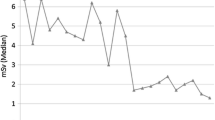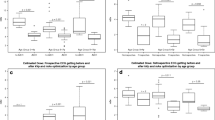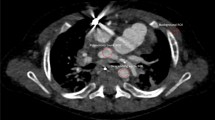Abstract
The aim of the study is to describe the spectrum of indications for pediatric ECG-synchronized CT angiography (CTA), the main determinants of radiation exposure, and trends in radiation dose over time at a single, tertiary referral center. The study was IRB approved and HIPAA compliant with informed consent waived. Between 2005 and 2013, 324 pediatric patients underwent ECG-synchronized CTA to evaluate known or suspected cardiovascular abnormalities (109 female, median age 8.1 years). The effective dose (ED) was calculated using age-specific correction factors. Univariate and multivariate regression analyses were performed to identify predictors of radiation dose. The most common primary indications for the CTA examinations included known or suspected coronary pathologies (n = 166), complex congenital heart disease (n = 73), and aortic pathologies (n = 41). Median radiation exposure decreased from 12 mSv for patients examined in the years 2005–2007 to 1.2 mSv for patients examined in the years 2011–2013 (p < 0.001). Patients scanned using a tube potential of 80 kV (n = 259) had a significantly lower median radiation dose (1.4 mSv) compared to patients who were scanned at 100 kV (n = 46, median 6.3 mSv) or 120 kV (n = 19, median 19 mSv, p < 0.001). Tube voltage, followed by tube current and the method of ECG-synchronization were the strongest independent predictors of radiation dose. Growing experience with dose-saving techniques and CTA protocols tailored to the pediatric population have led to a tenfold reduction in radiation dose over recent years and now allow routinely performing ECG-synchronized CTA in children with a radiation dose on the order of 1 mSv.





Similar content being viewed by others
References
Bacher K, Bogaert E, Lapere R, De Wolf D, Thierens H (2005) Patient-specific dose and radiation risk estimation in pediatric cardiac catheterization. Circulation 111:83–89
Bischoff B, Hein F, Meyer T et al (2009) Impact of a reduced tube voltage on CT angiography and radiation dose: results of the PROTECTION I study. JACC Cardiovasc Imaging 2:940–946
Cheng Z, Wang X, Duan Y et al (2010) Detection of coronary artery anomalies by dual-source CT coronary angiography. Clin Radiol 65:815–822
Chinnaiyan KM, Boura JA, DePetris A et al (2013) Progressive radiation dose reduction from coronary computed tomography angiography in a statewide collaborative quality improvement program: results from the advanced cardiovascular imaging consortium. Circ Cardiovasc Imaging 6:646–654
Deak PD, Smal Y, Kalender WA (2010) Multisection CT protocols: sex- and age-specific conversion factors used to determine effective dose from dose-length product. Radiology 257:158–166
Frush DP, Yoshizumi T (2006) Conventional and CT angiography in children: dosimetry and dose comparisons. Pediatr Radiol 36(Suppl 2):154–158
Ghoshhajra BB, Lee AM, Engel LC et al (2013) Radiation dose reduction in pediatric cardiac computed tomography: experience from a Tertiary Medical Center. Pediatr Cardiol. doi:10.1007/s00246-013-0758-5
Han BK, Lindberg J, Overman D, Schwartz RS, Grant K, Lesser JR (2012) Safety and accuracy of dual-source coronary computed tomography angiography in the pediatric population. J Cardiovasc Comput Tomogr 6:252–259
Hausleiter J, Meyer T, Hermann F et al (2009) Estimated radiation dose associated with cardiac CT angiography. JAMA 301:500–507
Hausleiter J, Meyer TS, Martuscelli E et al (2012) Image quality and radiation exposure with prospectively ECG-triggered axial scanning for coronary CT angiography: the multicenter, multivendor, randomized PROTECTION-III study. JACC Cardiovasc Imaging 5:484–493
Henzler T, Hanley M, Arnoldi E, Bastarrika G, Schoepf UJ, Becker HC (2010) Practical strategies for low radiation dose cardiac computed tomography. J Thorac Imaging 25:213–220
Herzog C, Mulvihill DM, Nguyen SA et al (2008) Pediatric cardiovascular CT angiography: radiation dose reduction using automatic anatomic tube current modulation. Am J Roentgenol 190:1232–1240
Kim JW, Goo HW (2013) Coronary artery abnormalities in Kawasaki disease: comparison between CT and MR coronary angiography. Acta Radiol 54:156–163
Lee T, Tsai IC, Fu YC et al (2006) Using multidetector-row CT in neonates with complex congenital heart disease to replace diagnostic cardiac catheterization for anatomical investigation: initial experiences in technical and clinical feasibility. Pediatr Radiol 36:1273–1282
Mathews JD, Forsythe AV, Brady Z et al (2013) Cancer risk in 680,000 people exposed to computed tomography scans in childhood or adolescence: data linkage study of 11 million Australians. BMJ 346:f2360
Meijboom WB, Meijs MF, Schuijf JD et al (2008) Diagnostic accuracy of 64-slice computed tomography coronary angiography: a prospective, multicenter, multivendor study. J Am Coll Cardiol 52:2135–2144
Meinel FG, Huda W, Schoepf UJ et al (2013) Diagnostic accuracy of CT angiography in infants with tetralogy of Fallot with pulmonary atresia and major aortopulmonary collateral arteries. J Cardiovasc Comput Tomogr 7:367–375
Miglioretti DL, Johnson E, Williams A et al (2013) The use of computed tomography in pediatrics and the associated radiation exposure and estimated cancer risk. JAMA Pediatr. doi:10.1001/jamapediatrics.2013.311:1-8
Nie P, Wang X, Cheng Z, Ji X, Duan Y, Chen J (2012) Accuracy, image quality and radiation dose comparison of high-pitch spiral and sequential acquisition on 128-slice dual-source CT angiography in children with congenital heart disease. Eur Radiol 22:2057–2066
Raff GL, Chinnaiyan KM, Share DA et al (2009) Radiation dose from cardiac computed tomography before and after implementation of radiation dose-reduction techniques. JAMA 301:2340–2348
Rassow J, Schmaltz AA, Hentrich F, Streffer C (2000) Effective doses to patients from paediatric cardiac catheterization. Br J Radiol 73:172–183
Schmitt R, Froehner S, Brunn J et al (2005) Congenital anomalies of the coronary arteries: imaging with contrast-enhanced, multidetector computed tomography. Eur Radiol 15:1110–1121
Takx RA, Moscariello A, Schoepf UJ et al (2012) Quantification of left and right ventricular function and myocardial mass: comparison of low-radiation dose 2nd generation dual-source CT and cardiac MRI. Eur J Radiol 81:e598–e604
Tricarico F, Hlavacek AM, Schoepf UJ et al (2013) Cardiovascular CT angiography in neonates and children: image quality and potential for radiation dose reduction with iterative image reconstruction techniques. Eur Radiol 23:1306–1315
Conflict of interest
Dr. Schoepf is a consultant for and receives research support from Bayer, Bracco, GE and Siemens. The other authors have no conflict of interest to disclose.
Ethical standards
This research has been approved by the appropriate ethics committee and was performed in accordance with the ethical standards laid down in the 1964 Declaration of Helsinki and its later amendments.
Author information
Authors and Affiliations
Corresponding author
Electronic supplementary material
Below is the link to the electronic supplementary material.
Rights and permissions
About this article
Cite this article
Meinel, F.G., Henzler, T., Schoepf, U.J. et al. ECG-Synchronized CT Angiography in 324 Consecutive Pediatric Patients: Spectrum of Indications and Trends in Radiation Dose. Pediatr Cardiol 36, 569–578 (2015). https://doi.org/10.1007/s00246-014-1051-y
Received:
Accepted:
Published:
Issue Date:
DOI: https://doi.org/10.1007/s00246-014-1051-y




